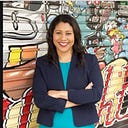Meeting San Francisco’s Affordable Housing Goals
Last month I announced Housing for All, an initiative to fundamentally change how San Francisco approves and builds housing and to fulfill the promises made in San Francisco’s Housing Element. While Housing for All is about building housing at all affordability levels, we know we must respond to the City’s ever-growing need to deliver affordable housing options that will house our workers, keep communities in place, and ensure that every San Franciscan has a place to call home.

There are no simple solutions to the affordability challenges we face. High construction costs and barriers to development make San Francisco the most expensive place in the country to build affordable housing. The City currently faces a $728 million budget deficit over the next two years that limits what local funding we have. State and federal affordable housing funding has failed to adequately meet growing demands from cities and counties across California.
Despite these challenges, I am committed to meeting the San Francisco’s affordable housing needs.
What is Affordable Housing?
In everyday speech, the term “affordable housing” can mean many different things. By state law, however, housing is “affordable” when the renter pays no more than 30% of their income on rent.
Of the 82,000 homes that San Francisco must accommodate over the next eight years, 46,000 must be affordable. This target of 46,000 affordable homes is actually divided into multiple levels of affordability, according to state requirements. For instance, around 1/3 of those units need to be affordable to households making 50% to 80% of Area Median Income (AMI), which is a salary of around $62,000-$99,000 for a family of three. An SFUSD educator raising two kids on their own would likely fall into this category. The chart below shows the breakdown of our affordable housing targets in our Housing Element.

Given the cost of building and maintaining housing, most affordable units require public subsidy. For units affordable at moderate incomes, in the middle of the income spectrum, the market can sometimes provide housing without subsidy. For example, accessory dwelling units (ADUs), often referred to as in-law units or granny flats and added in garage areas, storage spaces, or yards, can be found at rents affordable at moderate incomes.
The Affordable Housing Leadership Council
To reach our goal of building over 46,000 affordable units, we will need to think outside the box, harnessing San Francisco’s innovative can-do spirit. That’s why City staff will be convening an Affordable Housing Leadership Council, which will help the City chart a path forward for meeting our affordable housing goals. This Council will work closely with City staff over the next 11 months to develop a strategy to rethink how we approach affordable housing in San Francisco. This strategy will be informed by an analysis of San Francisco’s current affordable housing funding landscape and will focus on specific goals, including:
- Exploring new local and regional funding tools: We must innovate around how we finance affordable housing, and the Leadership Council will help us identify new strategies for funding affordable housing. These may include local and regional bond measures, infrastructure finance districts (IFD), or new models such as Joint Powers Authorities (JPA).
- Reducing costs for affordable housing projects: Many City-imposed requirements raise affordable housing project costs and reduce the number of affordable units that we can build. The Leadership Council will determine how the City can streamline and reform policies such as the City’s public art and power requirements for affordable housing, which add millions in costs per project.
- Advocating at the federal and state levels for more resources The Leadership Council will help the City develop a strategy for securing more state and federal funding for affordable housing in San Francisco. The Council may highlight changes to federal programs such as Low-Income Housing Tax Credits (LIHTC) and Housing Choice Vouchers that would result in more affordable housing units in San Francisco. It could also recommend specific expansions to state affordable housing resources including additional state bonds, permanent funding sources, and tax abatements.
This Council will include representatives with deep experience in affordable housing, including the following leaders in finance, philanthropy, nonprofit, academic, and business sectors: Fred Blackwell, CEO of the San Francisco Foundation; Rebecca Foster, CEO of the San Francisco Housing Accelerator Fund; Carol Galante, Housing Researcher and Practitioner; Luis Granados, Executive Director of the Mission Economic Development Agency; Ann Silverberg, CEO of Related California’s Northern California Affordable and Northwest Divisions; Malcolm Yeung, Executive Director of the Chinatown Community Development Center; and Jim Wunderman, President and CEO of the Bay Area Council. The Council will work in close partnership with the City’s Interagency Housing Element Implementation Team, MOHCD, and the Planning Department.
Recognizing Successes, Broadening Horizons
The work of the Affordable Housing Leadership Council will complement the City’s ongoing efforts to meet our affordable housing needs. San Francisco voters have supported bonds to raise over $1.17 billion for affordable housing funding since 2015, including the $600 million bond I sponsored in 2019. These resources, along with other local sources, have allowed us to stabilize communities and build and preserve affordable homes for thousands of San Francisco families.

While our historic investments have made a meaningful difference to our communities, it is important we recognize the scale of the need we are facing. Under our current system for regulating and building affordable housing, it would take an estimated $14 billion in additional City resources to build the 46,000 affordable units we need in the next eight years. This makes clear that we must think creatively, harnessing the ideas of the Leadership Council described above.
To complement the work of the Leadership Council, we must also continue the work that my administration has already begun to accelerate our construction of affordable housing, including the following initiatives that are already underway.
Funding Affordable Housing Through Market-Rate Development
We cannot rely exclusively on government-funded 100% affordable housing. The reality is that market-rate projects play a critical role in both funding and directly producing affordable housing through our Inclusionary Housing program, and we need more housing of all types to help support our affordable housing goals.
We also need to amend our inclusionary laws so that they aren’t a barrier to producing affordable housing. Right now, the Controller is conducting an analysis to understand the feasibility of building new housing under different inclusionary levels. If our number is too high, and it blocks housing from being built, then that produces zero affordable housing. If by lowering the number we can actually build more housing, we can increase our affordable housing production from where we are today.
This is at the heart of what Housing for All will do. By removing barriers to building new housing, and by rezoning neighborhoods across our entire city, we can create more housing, including affordable housing.
Unlocking our Housing Pipeline
There are over 52,000 approved units of housing in our pipeline, and of those, more than 15,000 are affordable. So many of these homes, many of which are part of larger development projects, are stuck due to rising construction costs and other economic and bureaucratic challenges. We have to get these projects moving, and I’ve introduced legislation to do just that.
Specifically, my legislation will finance the infrastructure construction that these large projects need — the roads, the pipes, the power lines — so the developers can start building housing. One project, Potrero Power Station, is ready to move forward using this proposal. If the Board of Supervisors approves the legislation to finance the infrastructure, the Power Station can break ground on new workforce housing this year. Beyond the Power Station, there are affordable units across our entire city that can benefit from this infrastructure financing program, and we hope to add more projects to the program soon.
This is what I mean by being creative around solutions to build housing. By using new tools to unlock the City’s pipeline projects, we can quickly deliver thousands of new units of affordable housing.
Expanding State and Federal Support for Affordable Housing
To achieve our affordable housing goals, we can’t just rely on local efforts. We also need support from the State and Federal Governments. For example, the State’s investment of nearly $350 million of California Housing Accelerator funding has been critical to San Francisco’s affordable housing production, allowing eight shovel-ready affordable housing projects to move forward in San Francisco in the past year.
It also takes efforts like Senator Wiener’s replacement housing legislation, Senate Bill 593, which the City is sponsoring. If passed, SB 593 would provide San Francisco with a narrow and tailored funding source for replacing more than 5,800 units of low- and moderate-income housing that were demolished through Redevelopment from the 1950s to 1970s. Like our legislation to unlock the housing pipeline, this is a creative solution that will help us to build more affordable housing. It is also an important measure to begin reversing the harms of mass displacement of lower-income black and brown families that occurred during the era of so-called urban renewal. This bill was introduced just recently and is currently going through the legislative process in Sacramento. If approved and signed by the Govenor, this would become a great tool for helping us to meet our affordable goals.
The City has also been advocating for change at the national level to make federal funding for affordable housing go further by making technical but impactful changes to the low-income housing tax credit (LIHTC) program. While housing affordability is a long-standing problem in the Bay Area, it is increasingly a national problem. The lowest income renters struggle throughout the country to keep a stable, safe roof over their heads.
An expansion of federal rental assistance programs, through programs like Housing Choice Vouchers (also known as Section 8) and Project-Based Vouchers, would help San Francisco and thousands of other cities and towns around the country prevent homelessness and stabilize our most vulnerable residents. We will be doubling down on efforts to win additional federal resources while coordinating with like-minded partners in other cities.

Next Steps
These are just a few examples of the strategies we need to pursue in the years ahead if we want to meet our affordable housing goals. Our housing shortage requires us to be creative and to change how we think about housing, and I am asking the City to put forward many more ideas over the next eight years.
Starting in March, our Affordable Housing Leadership Council will help to guide us and make recommendations about what is possible looking forward as the City continues the work we’ve already begun. Housing for All will take diligence, partnership, and creativity, and I’m confident we can take this work on and change how we think about housing here in San Francisco.









